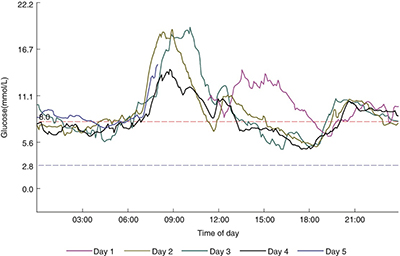
6. Consensus and Recommendations on |

![]() Continuous glucose monitoring (CGM) technology has evolved tremendously in recent years, and has become an effective complement to traditional blood glucose monitoring (BGM) methods, and is now a days widely used in the clinical setting. However, the advantages, clinical indications, accuracy evaluation of the technology and interpretation of the CGM results are not much known to Indian physicians and patients, limiting its use to only a few centres.
Continuous glucose monitoring (CGM) technology has evolved tremendously in recent years, and has become an effective complement to traditional blood glucose monitoring (BGM) methods, and is now a days widely used in the clinical setting. However, the advantages, clinical indications, accuracy evaluation of the technology and interpretation of the CGM results are not much known to Indian physicians and patients, limiting its use to only a few centres.
![]() Diabetes India Task Force of experts took up the task to create the Indian Clinical Guidelines for CGM, in accordance to the published in international guidelines and Indian studies plus clinical experiences to provide the geographic specific information on CGM for Indian population.
Diabetes India Task Force of experts took up the task to create the Indian Clinical Guidelines for CGM, in accordance to the published in international guidelines and Indian studies plus clinical experiences to provide the geographic specific information on CGM for Indian population.
![]() Indian Clinical Guidelines for CGM recommends CGM use in the following patients and situations:
Indian Clinical Guidelines for CGM recommends CGM use in the following patients and situations:
- T1DM
![]() T1DM adults: CGM is recommended particularly for patients with a history of severe hypoglycaemia, hypoglycaemia unawareness and to assist in the correction of hyperglycaemia in patients, not at target. Strongly recommended that CGM users must know the basics of sensor insertion, calibration, and real time data interpretation.
T1DM adults: CGM is recommended particularly for patients with a history of severe hypoglycaemia, hypoglycaemia unawareness and to assist in the correction of hyperglycaemia in patients, not at target. Strongly recommended that CGM users must know the basics of sensor insertion, calibration, and real time data interpretation.
![]() T1DM children: Same as adult T1DM. Both prevalence and persistence of use of CGM are lower in children than adults. Strongly recommended that more in depth training, as well as a more frequent follow up, is required to enable children to adopt the technology more successfully.
T1DM children: Same as adult T1DM. Both prevalence and persistence of use of CGM are lower in children than adults. Strongly recommended that more in depth training, as well as a more frequent follow up, is required to enable children to adopt the technology more successfully.
- T2DM
![]() T2DM receiving intensive insulin regimens (including multiple daily injections or insulin pump therapy)/sulfonylureas, glinides: Strongly recommended.
T2DM receiving intensive insulin regimens (including multiple daily injections or insulin pump therapy)/sulfonylureas, glinides: Strongly recommended.
![]() T2DM with low risk of hypoglycaemia: Based on treating physician’s discretion.
T2DM with low risk of hypoglycaemia: Based on treating physician’s discretion.
- Gestational diabetes mellitus (GDM)
![]() CGM during pregnancy can be used as a teaching tool, to evaluate glucose patterns and to fine-tune insulin dosing.
CGM during pregnancy can be used as a teaching tool, to evaluate glucose patterns and to fine-tune insulin dosing.
![]() CGM in pregnancy can supplement BGM, in particular for monitoring nocturnal hypoglycaemia or hyperglycaemia and post prandial hyperglycaemia.
CGM in pregnancy can supplement BGM, in particular for monitoring nocturnal hypoglycaemia or hyperglycaemia and post prandial hyperglycaemia.
- Diabetes education
![]() CGM can help patients to understand blood glucose fluctuations caused by factors such as exercise, meals, stress and hypoglycaemic treatment, thereby instilling healthy lifestyle choices. It helps increase compliance and promote more effective communication between patients and doctors.
CGM can help patients to understand blood glucose fluctuations caused by factors such as exercise, meals, stress and hypoglycaemic treatment, thereby instilling healthy lifestyle choices. It helps increase compliance and promote more effective communication between patients and doctors.
- Patients with diabetic gastroparesis, fulminant T1DM and other special types of diabetes
![]() Can use CGM to understand the characteristics and fluctuation patterns of their blood glucose profile.
Can use CGM to understand the characteristics and fluctuation patterns of their blood glucose profile.
- CGM can also be applied to other endocrine and metabolic disorders including insulinoma
For enquiries info@jothydev.net.
Please visit: jothydev.net | research.jothydev.com | diabscreenkerala.net | jothydev.com/newsletter
